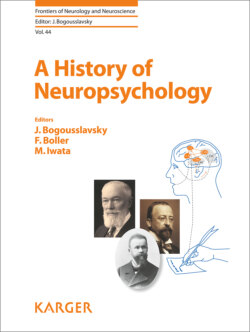Читать книгу A History of Neuropsychology - Группа авторов - Страница 62
На сайте Литреса книга снята с продажи.
Responsible Lesions
ОглавлениеImura speculated that responsible lesions for Gogi aphasia are rather diffuse, involving the second and third temporal gyri and adjacent parietal lobe on the left side [16].
One of his cases (the above quoted case E) had been slowly deteriorating, leading Imura to presume a possibility of presenile dementia for its etiology [6]. The autopsy finding described by Pick of the case with “surdite verbale representative” (case F) which had also been slowly progressive showed the presence of diffuse cerebral atrophy, mainly affecting the left temporal lobe [15].
In 1991, Kurachi and Matsubara reported their experience on 11 cases of clinically diagnosed Pick’s disease, of them three had been autopsy confirmed [20]. Of the three, one had been reported as a typical case of Gogi aphasia 7 years earlier [21]. The case showed prominent bilateral atrophy of the middle and inferior temporal gyrus and the fusiform gyrus, but the extent of atrophy was much stronger on the left side.
In the following year, Tanabe et al. [7] reported their experience on 7 cases of Gogi aphasia, of which 6 were diagnosed as suffering from Pick’s disease of temporal lobe type. All the diagnosis was based on the findings of CT or MRI studies, which showed bilateral atrophy of the anterior and middle temporal lobes, the left being more affected. The present author also encountered 2 cases of typical Gogi aphasia caused by temporal lobe degeneration [9, 22].
But it has to be emphasized that Pick’s disease is not the only cause of Gogi aphasia. Imura’s 2 other cases suffered from non-progressive brain pathology, that is, hemorrhage and infarction. The patient of Sasanuma and Monoi [5] suffered from a head trauma. A surgical operation confirmed the presence of brain contusion as well as hematoma in the left second and third temporal gyri and the parietal lobe. Tanabe’s experience includes a case of herpes simplex encephalitis [7]. Such non-progressive etiology continues to be reported. For instance, Matsuda et al. [10] described 2 cases of stroke and one case of head trauma with MRI confirmation. Funayama described a case of cerebral infarction caused by sinus thrombosis [23].
Thus, it seems there are 2 types of Gogi aphasia. One is progressive, and wider mental deterioration eventually ensues. This type is closely associated with Pick’s disease of temporal lobe type [20]. The lesion involves bilateral temporal lobes even though the atrophy of the left side is much more prominent. The other is caused by various etiologies such as stroke, trauma, and encephalitis involving the lower temporal lobe. Symptoms of this type either remain stable or improve. The herpes simplex case and traumatic cases almost certainly must have suffered from bilateral damage of the temporal lobes. Even with stroke cases, bilateral lesions were demonstrated by MRI studies [10]. Thus, bilateral lesions of the temporal lobes seem to be a necessary condition for the emergence of Gogi aphasia. But the possibility of a left unilateral lesion causing this unique loss of lexical meaning cannot be easily discarded [23].
